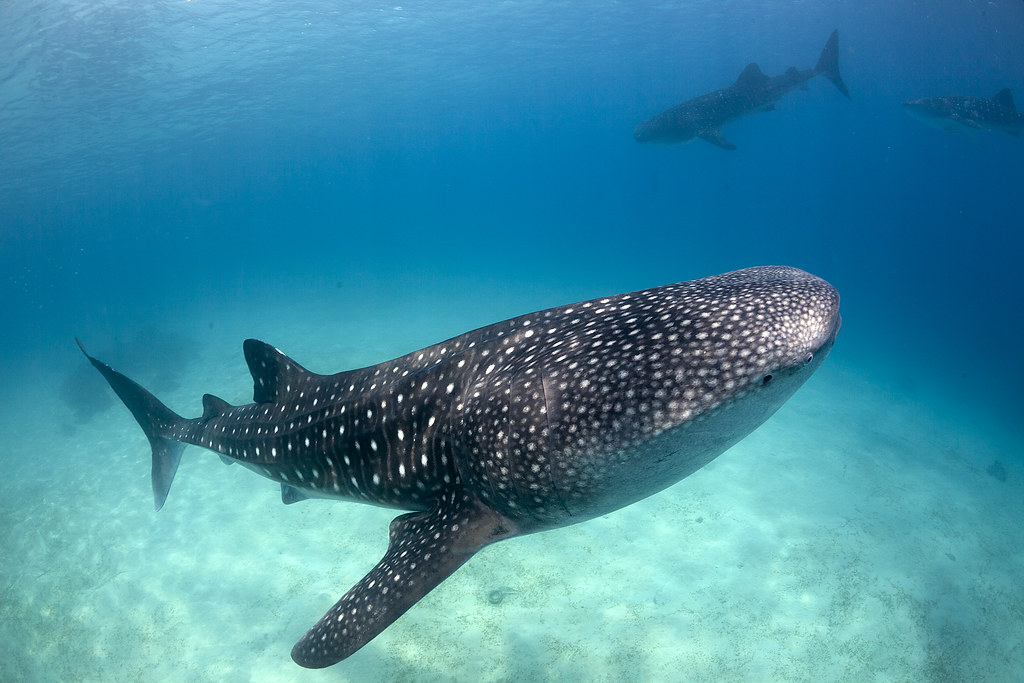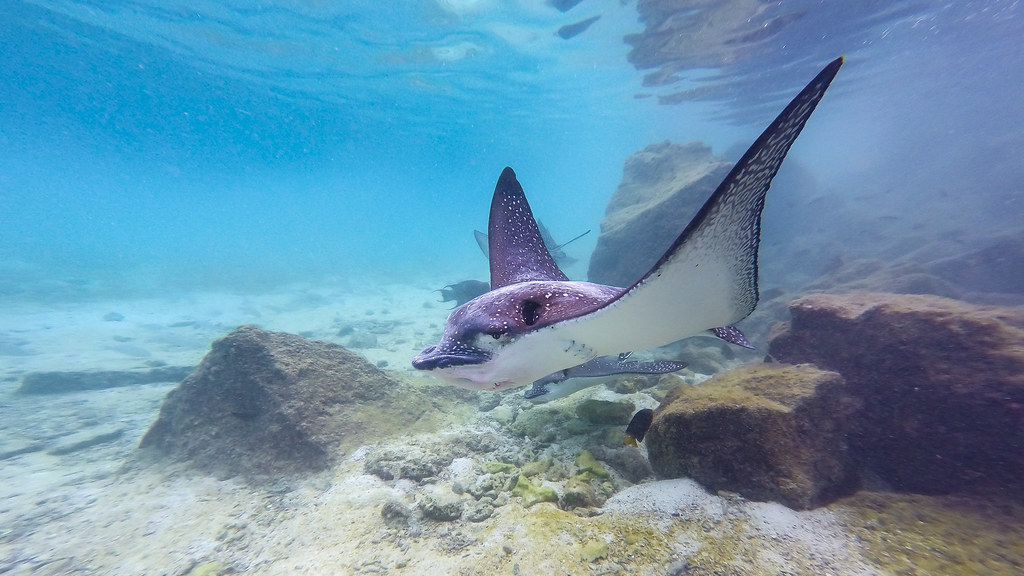1/3鯊魚和魟魚恐因過度捕撈消失 科學家推追蹤技術「救鯊鯊」
環境資訊中心外電;姜唯 翻譯;林大利 審校;稿源:ENS
一項為國際自然保育聯盟(International Union for Conservation of Nature, IUCN)受脅物種紅皮書進行的研究發現,全球海洋中超過1/3的鯊魚和魟魚現在因過度捕撈而瀕臨滅絕。

全球海洋中超過1/3的鯊魚和魟魚現在因過度捕撈而瀕臨滅絕。照片來源:Klaus Stiefel(CC BY-NC 2.0)
研究:熱帶地區鯊魚和魟魚的滅絕風險特高
這份研究有24位共同作者,由IUCN鯊魚專家小組聯合主席、不列顛哥倫比亞省西蒙弗雷澤大學(Simon Fraser University)加拿大海洋生物多樣性和保育研究主席杜維(Nicholas Dulvy)領軍,其他作者包括來自世界各地的鯊魚和魟魚專家。
在這首次的全球性重新評估中,科學家們根據IUCN紅皮書準則測量了1199種鯊魚、魟魚和銀鮫屬物種,發現391(32%)種屬於極危級、瀕危級或易危級。評估結果為這三個IUCN受脅等級的物種屬於受脅物種。
研究結論指出,熱帶地區鯊魚和魟魚的滅絕風險特別高,有可能喪失生態系統功能和服務。
研究者警告:「有三種物種已超過80年未被目擊,處於極度瀕危狀態(可能已經滅絕)。」他們相當肯定,「這些物種的枯竭是人類對食物持續需求所致。」
瀕危物種包括銀鮫屬,一種鯊魚和魟魚的近緣魚類。專家們發現,自2014年第一次全球評估以來,受威脅物種數增加了一倍,瀕危和極度瀕危物種數增加了兩倍多。
2009年第一次針對64種公海或遠洋鯊魚和魟魚進行的全球保育狀況研究顯示,32%的物種面臨滅絕風險,IUCN鯊魚專家小組認為主因就是過度捕撈。
世界危機重重 滅絕危機迫在眉睫
世界自然基金會(WWF)呼籲各國政府和區域漁業機構立即採取行動,停止過度捕撈並防止全球滅絕危機。
WWF全球鯊魚和魟魚保育計畫負責人康尼遜(Andy Cornish)博士說:「鯊魚和魟魚的處境非常危險⋯⋯我們可能開始一個物種接著一個物種地失去這些古老的生物。現在起,我們需要政府更有魄力的行動來限制捕撈,將這些具有重要功能的動物從滅絕邊緣救回。」
「這是個關鍵時刻。如果我們現在採取行動,仍然很有機會拯救這些攸關海洋健全的掠食者。然而,如果維持現狀,緩慢地改善管理,那麼鯊魚和魟魚物種開始在我們的眼皮下消失也不意外。」
最瀕危的鯊魚和魟魚需要復育計畫,減少意外死亡或被漁具纏住的事件。
對於那些仍然可以維持捕撈的物種,應嚴格執行以科學為基礎的捕撈限制,防止數量下降甚至得以復育。
在捕撈限制不可行的情況下,保護鯊魚和魟魚的重要棲息地,並減少意外死亡或被漁具纏住的機會,可以緩解過度捕撈的後果。
終結過度捕撈的其中一個關鍵是有效監測捕撈量和海上捕撈活動。為此,WWF正在推動在商業漁船上使用錄影系統和船舶監控系統,提高合規性並收集更準確的資料進行科學分析。

鷂鱝(Eagle ray)是像鷹一般的魟魚。照片來源:VaqueroFrancis(CC BY-NC-ND 2.0)
「可追溯性」是保護的關鍵
25日在澳洲舉行的世界漁業大會上,國際野生動植物貿易監測組織TRAFFIC展示了「SharkTrace」,一套可幫助解決鯊魚和魟魚族群危機的創新應用程式。
SharkTrace能利用科技來追踪物種從被捕獲到消費的過程,簡單、使用者友善且具有成本效益專,能用於漁船、魚類加工廠和運輸車輛,確保整個供應鏈的透明度。
「了解何時、何地、如何以及誰捕獲了該件鯊魚產品,以及其到達消費者的旅程中的每個環節,對於阻止鯊魚和魟魚族群的驟減至關重要,但截至目前還沒有專門的貿易機制來識別鯊魚來源是否合法,」TRAFFIC漁業貿易高級顧問桑特(Glenn Sant)說。
接下來的幾個月至數年,TRAFFIC將在亞洲和非洲進一步海上試驗,同時與產業和政府合作,用SharkTrace協助他們管理鯊魚和魟魚的漁業和貿易。
「隨著SharkTrace進入推廣階段,我們將尋求漁民、海鮮貿易商、政府和消費者的青睞。我們期待他們的洽詢並在未來幾年內與他們展開合作,」桑特說。
TRAFFIC今年開發一整套的工具,用來提高鯊魚貿易的可追溯性和永續性,其中包含世界上第一個3D列印魚翅。
這些3D列印魚翅是十幾種經常被貿易的鯊魚的真正乾魚翅掃描列印而成,其中11種是CITES列出的物種,包括無溝雙髻鯊(Great Hammerhead,學名:Sphyrna mokarran)、長鰭真鯊(Oceanic Whitetip,學名:Carcharhinus longimanus)和鐮狀真鯊(Silky Shark,學名:Carcharhinus falciformis),幫助執法人員辨識魚翅乾。
確保鯊魚和魟魚產品來自永續和合法的來源是漁民、管理者、貿易商、消費者和政府共同的責任。桑特說,SharkTrace將支持合法貿易商證明他們的產品是合法的並符合CITES野生動物貿易法規。他解釋說,積極識別合法產品將有助於揭露來自管理不善的漁業中的非法漁獲。
杜維博士說:「政府可以參考正在為鯊魚和魟魚開發追溯系統的地方,引進此類系統改善監測,確保管理措施被遵守,並全面性地提高鯊魚和魟魚產品貿易透明度。」
More than one-third of all sharks and rays in the world’s oceans are now at risk of extinction because of overfishing, finds a new study re-assessing their risk status on the authoritative Red List of Threatened Species compiled by the International Union for Conservation of Nature, IUCN.
The 24 co-authors on this analysis are led by Nicholas Dulvy, co-chair of the IUCN Shark Specialist Group and Canada Research Chair in Marine Biodiversity and Conservation at Simon Fraser University in British Columbia, where a handful of the other scientists on this study also are based.
Other authors are shark and ray experts from: Queensland, Australia; Dubai, UAE; Wellington, New Zealand; Cambridge, UK; Sri Lanka; Chennai, India; Ceara, Brazil; Florida; Indiana; and Georgia.
In this first global reassessment, the scientists measured 1,199 shark, ray, and chimaera species against IUCN Red List criteria and found 391 (32 percent) qualify as Critically Endangered, Endangered, or Vulnerable. Species classified in these three IUCN categories are considered threatened with extinction.
The authors concluded that a disproportionate threat to sharks and rays exists in the tropics, risking the loss of ecosystem functions and services.
They warned, “Three species not seen in >80 years are Critically Endangered (Possibly Extinct).”
And they determined that, “The depletion of these species has been driven by continuing demand for human food.”
The at-risk group of species includes chimaeras, which are fish related to sharks and rays. The experts found that the number of threatened species has doubled since the first global assessment in 2014, and the number of endangered and critically endangered species has more than tripled.
In 2009, the first study to determine the global conservation status of 64 species of open ocean, or pelagic, sharks and rays revealed that 32 percent were threatened with extinction, primarily due to overfishing, according to the IUCN Shark Specialist Group.
Amidst the World’s Many Crises, the Extinction Crisis is Urgent
The wildlife conservation group WWF is calling on governments and regional fisheries bodies to act immediately to stop overfishing and prevent a global extinction crisis.
“The alarm bells could not be ringing louder for sharks and rays,” said Dr. Andy Cornish, leader of WWF’s global shark and ray conservation program.
“We are on the cusp of starting to lose this ancient group of creatures, species by species right here, right now. Starting now, we need far greater action by governments to limit fishing and bring these functionally important animals back from the brink,” Dr. Cornish urged.
“This is a pivotal moment in time. If we act now, we still have a good chance to save these predators that play such an important role in ocean health. However, if the status quo continues with slow incremental improvements in management, nobody should be surprised when shark and ray species start disappearing on our watch,” he warned.
The most endangered sharks and rays will need recovery plans that reduce accidental death or entanglement in fishing gear.
For those species that can still sustain fishing, well-enforced science-based catch limits can prevent declines and even lead to recoveries.
Where catch limits are not feasible, protecting critical habitats for sharks and rays and reducing accidental death or entanglement in fishing gear can curb overfishing.
A critical part of ending overfishing is effective monitoring of catches and fishing activities at sea. To that end, WWF is promoting the use of camera systems and vessel monitoring systems on board industrial fishing vessels to improve compliance and collect more accurate information for scientific analyses.
Traceability, a Key to Protection
Today at the World Fisheries Congress in Australia, the internationa wildlife trade monitoring charity TRAFFIC presented SharkTrace: a suite of innovative apps to help tackle this shark and ray population catastrophe.
SharkTrace uses technology to trace species from capture to consumption. Its simple, user-friendly, and cost-effective apps were designed for use onboard fishing vessels, in fish processing plants, and aboard transport vehicles to ensure transparency throughout the supply chain.
“Knowing when, where, how and who caught a shark product and every part of its journey to the consumer is vital to halt the free-fall decline in shark and ray populations, but there has been no dedicated trade-based mechanism to identify shark products from legal sources until now,” Glenn Sant, TRAFFIC’s Senior Advisor – Fisheries trade, said.
Over the coming months and years, TRAFFIC will conduct further at-sea trials across Asia and Africa while working with industry and governments to adopt SharkTrace to assist their management of shark and ray fisheries and trade.
“As we further progress SharkTrace to a roll-out phase we will be looking for take-up by fishers, seafood traders, governments and consumers. We look forward to hearing of their interest and working with them in the coming years,” Sant said.
These apps add to the suite of tools created by TRAFFIC in 2021 to enhance traceability and sustainability in the shark trade, including the world’s first-ever 3D-printed shark fins.
The replica fins represent a dozen regularly traded sharks, eleven of them CITES-listed species, including Great Hammerhead, Oceanic Whitetip, and Silky sharks, created from 3D scans of real dried shark fins.
Ensuring shark and ray products derive from sustainable and legal sources is the responsibility of fishers, managers, traders, consumers and governments. Sant says SharkTrace will support legitimate traders to demonstrate that their products are legal and meet CITES wildlife trade regulations. Positively identifying legal products will help expose illegal catch taken from poorly managed fisheries, he explained.
Dr. Nicholas Dulvy, the professor at Simon Fraser University who led the IUCN Shark Specialist Group assessment, said, “Governments could be taking advantage of where traceability systems are being developed for shark and rays, introducing such systems as a backbone to better monitoring, assuring compliance with management measures and a general heightened level of transparency within the trade of shark and ray products.”
※ 全文及圖片詳見:ENS
查看原始文章>
【全文轉載自環境資訊中心】
(CC BY-NC-ND 4.0)
❤️~ 讓愛遠播 點亮他人 ~❤️
【惜食自介懶人包:惜食行善網是什麼? 可以做什麼?】
''你今天做善事了嗎?''
行善讓您改變一個弱勢者的人生,
也讓您能得到心中的富足與圓滿。
【惜食行善網】讓您可以隨時隨地的做善事
